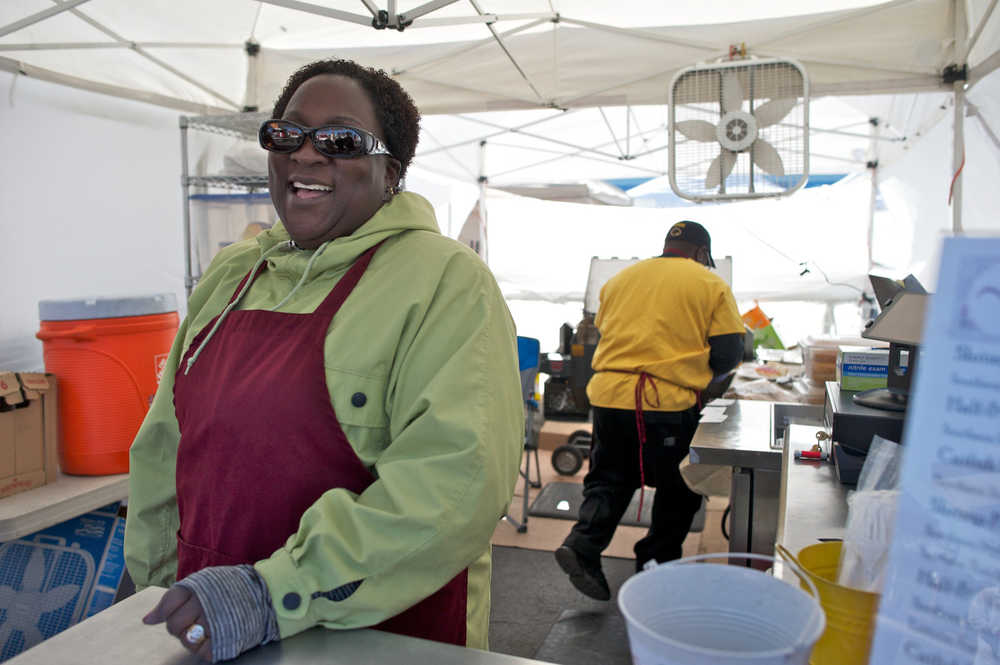On the eve of President Barack Obama’s trip to Alaska, visitors from all over the state have travelled to Anchorage.
At the Dena’ina Convention Center, Beth Kerttula walked in the door with the President’s science adviser, John Holdren.
Last year, Kerttula was named the White House ocean policy director. On Sunday, she was smiling and explaining: “This is my boss.”
Elaine Schroeder came from the capital city to Anchorage on a humbler but no less important mission.
She and five or six other Juneauites intend to participate in a rally scheduled for noon to 2 p.m. today on the Anchorage Park Strip.
During his trip, the President is expected to focus on the importance of fighting climate change, and Schroeder said their goal is supplementary:
“We feel we are giving the President the support he needs to go even further in his actions to fight climate change,” she said.
While Schroeder and other members of the Alaska Climate Action Network prepared signs Sunday night, Fran Ulmer, chairwoman of the U.S. Arctic Research Commission and former Juneau mayor, concluded a science expo in the NANA Regional Corp. offices.
Representatives of the U.S. Coast Guard from Juneau are also expected to attend
Monday’s conference, as are scientists based in the capital city.
The President isn’t expected to do much meeting and greeting in Anchorage. Air Force One is scheduled to land Monday afternoon, whereupon he will be whisked to the Dena’ina Center to present the closing speech of the GLACIER conference focusing on climate change and responses to it.
On Tuesday, he’ll travel to Seward. On Wednesday, it’s off to Dillingham and Kotzebue, where he’ll become the first sitting president to travel north of the Arctic Circle.
On the day before the President’s visit, under a sunny sky and in a stiff wind a few blocks from the Dena’ina Center, throngs of Anchorage visitors walked through the Anchorage Market and Festival.
Most expressed positive feelings about the President’s visit, even if they had mixed opinions about the man himself.
Serving fried catfish and shrimp po’boy sandwiches at a booth called Simply Southern, Olivia Carr-Odom said having the President visit Anchorage is “a great honor.”
“I think it’s wonderful,” she said.
A state employee, Carr-Odom runs Simply Southern on weekends and has lived in Alaska for 45 years. She hopes the President’s visit gives him insight into how it differs from other places in the U.S.
“Alaska’s definitely a unique place,” she said. “It’s easy to say that things down in the Lower 48 are going to work here the same … and sometimes they don’t.”
She pointed to the example of the King Cove Road, a proposed project to connect the Alaska Peninsula town of King Cove to an airport at Cold Bay. The road, which would run through a wilderness area of the Izembek National Wildlife Refuge, was rejected by the U.S. Fish and Wildlife Service. Carr-Odom thinks that’s a mistake.
“Human life is much more important,” she said, referring to the availability of medevac flights.
One row of windblown tents away from Simply Southern, Mike Bloom sells T-shirts joking about Texas’ size compared to Alaska.
After selling a tiny “Texas-sized” T-shirt to a pair of Australian tourists looking for something to fit a stuffed Koala bear, Bloom said he thinks it’s exciting to have the President visit and that he’s “always glad when we get a little national recognition.”
“I deal with a lot of visitors,” he said, “and you’d be surprised how many are unaware of basic things about Alaska.”
He remembers a few years ago when someone asked him when the Bering Strait would freeze — the person wanted to drive across the ice to Russia.
Two tents down from Bloom was Robert Jaro, a longtime Alaskan and outdoorsman who has lived in Sutton for almost a half-century.
Jaro said the President isn’t his favorite person, and he asked that his words on that topic not be printed.
That doesn’t stop him from agreeing with Obama on the topic of climate change.
About 30 years ago, he dug a shallow cellar to keep things cool. His “natural refrigerator” kept food safe, but it thawed so much that he had to dig another —10 feet deep this time.
He’s seen swallows and thrushes disappear from the forest around his cabin, more wind and storms.
“These are the local climate changes that I’ve noticed,” he said.
“I agree there’s global climate change,” he said. “I think it’s definitely man-made.”
He gestured at the other booths around his at the fair. “Look at this stuff made in China,” he said. “China’s not going to cut back (on carbon emissions). Somebody’s got to cut back, and it might as well be us.”

